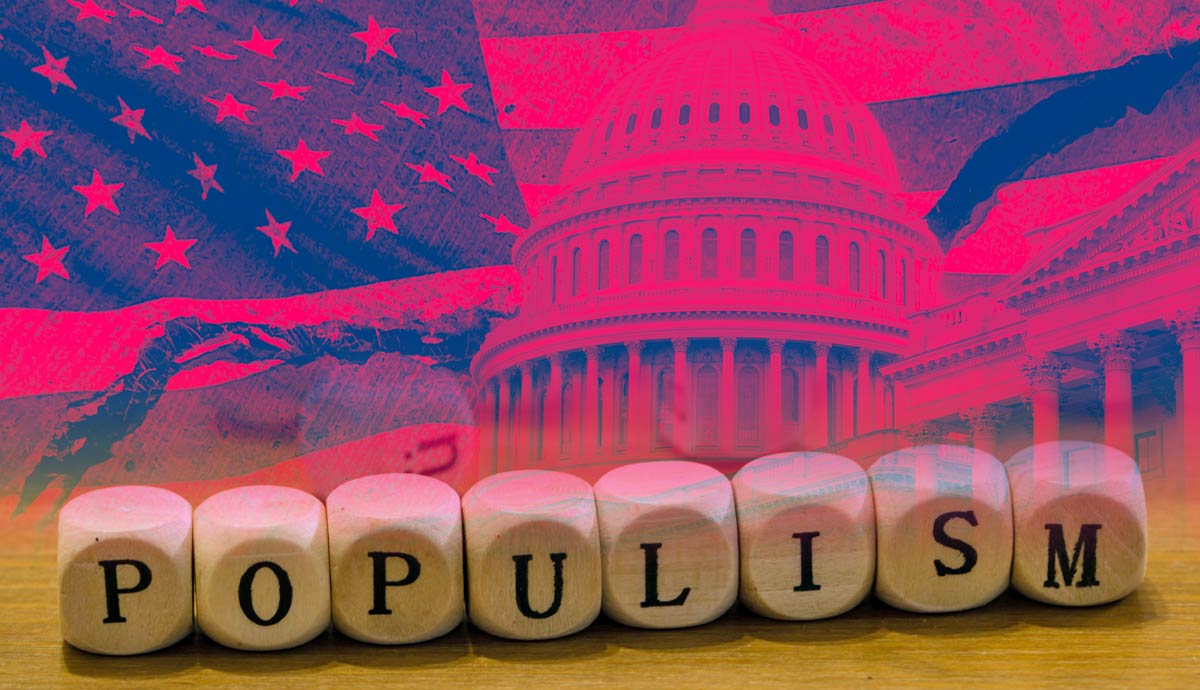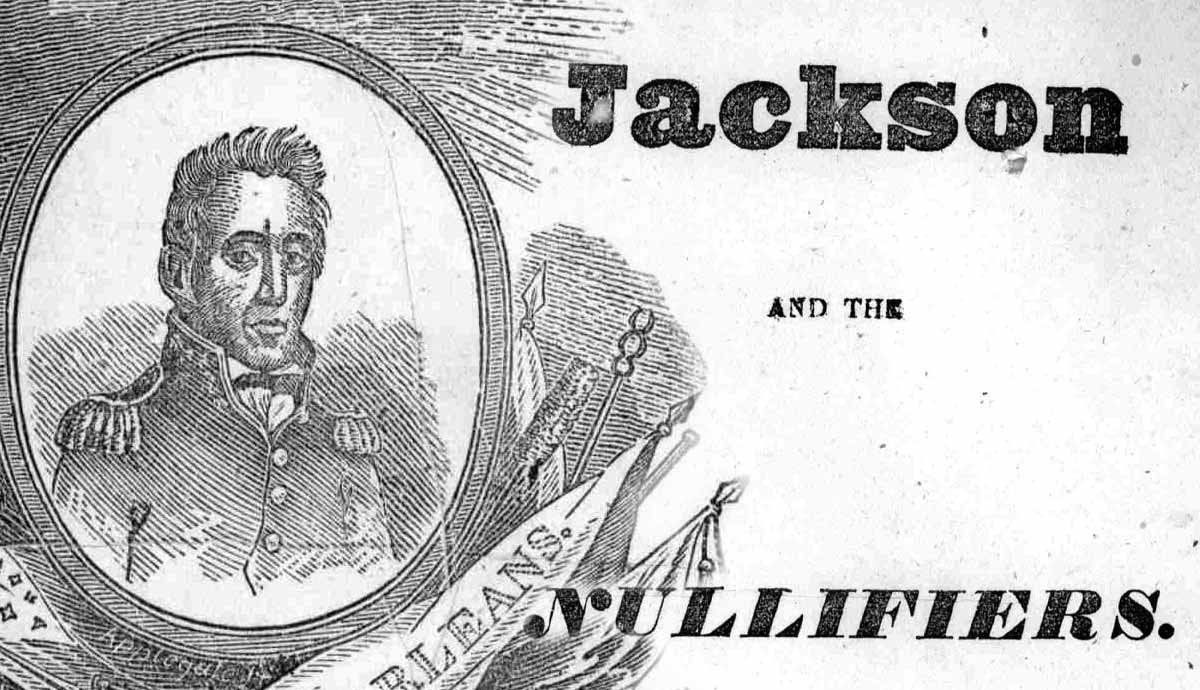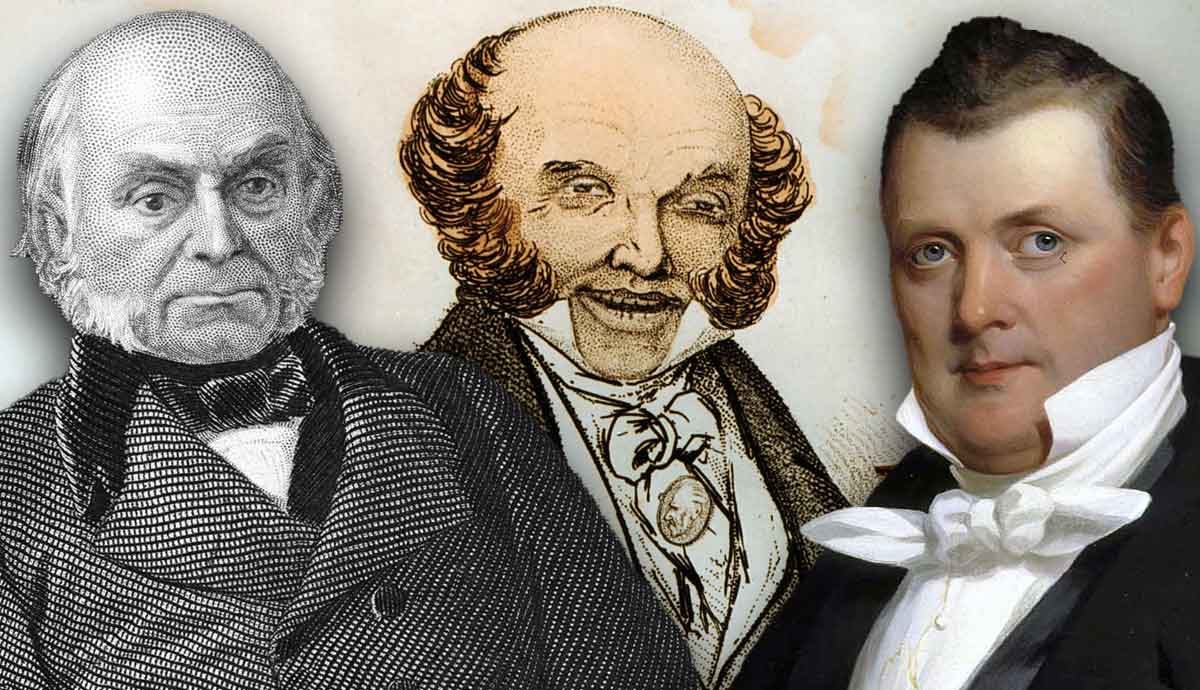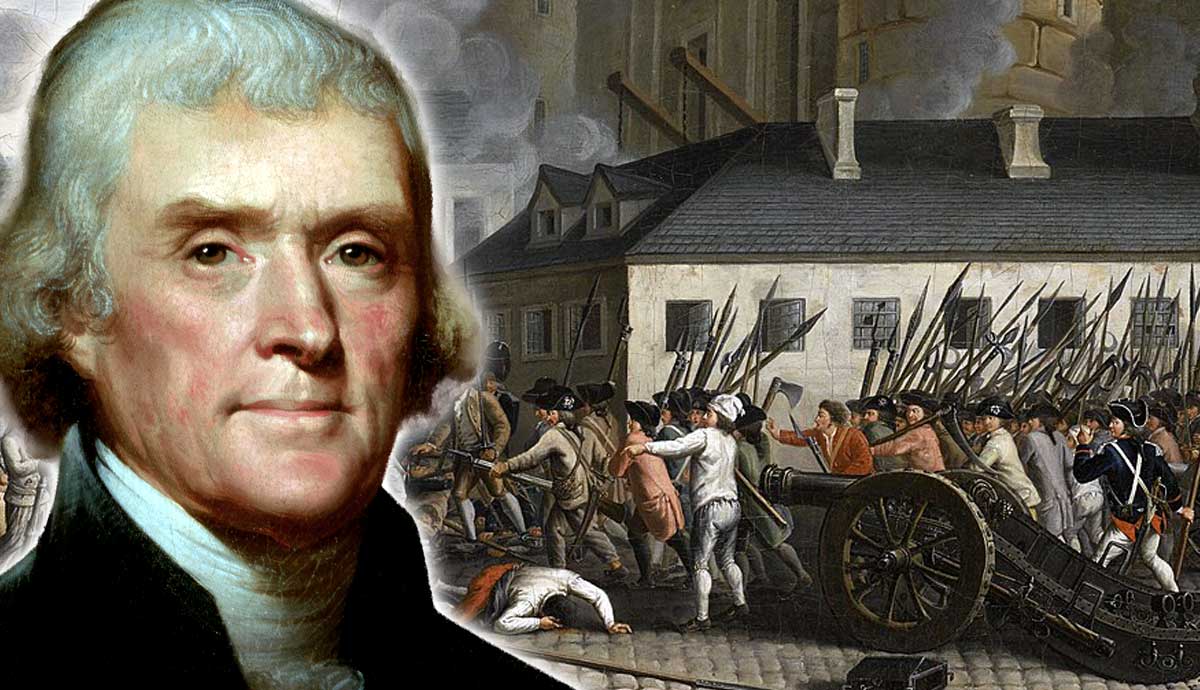
When we say “power of the people,” what does that mean? The US’s founders struggled with this question and created various checks and balances in the US Constitution to prevent the rise of tyranny through a majority faction. Over time, fear of the potentially radical whims of the common man cooled, and more political power was given to the voters. At various times, waves of populism have surged through American politics, both among progressives and conservatives.
So, what is populism? Who have been famous populist leaders in American history? How has populism affected our society as a whole? From the early days of the republic to the presidency of Donald Trump, here’s a look at populism in the United States.
Setting the Stage: No Taxation Without Representation

Populism, or a political focus on the well-being and desires of the common man, began in America during the colonial era. After the French and Indian War, the British increased taxes on the colonies to help pay back the funds spent on the conflict. Without any elected representatives in Britain’s Parliament, many colonists were upset at being taxed without representation. Thus, the famous rallying cry “no taxation without representation” was born. During the 1760s, political feuding between the colonists and Britain escalated, resulting in a series of increased taxes. Eventually, war broke out, and America won its independence through force of arms.
After winning its independence, the new United States of America was so opposed to taxation that its original governing document, the Articles of Confederation, provided no realistic means of revenue to fund a central government. Unfortunately, it was quickly determined that the thirteen states would not fund the central government voluntarily, resulting in a virtually nonexistent central government and no executive authority. Following Shays’ Rebellion in 1786, which had been sparked by populist rage against taxes and creditors, many leaders realized that the Articles needed to be amended to fix the revenue problem. This prompted the Constitutional Convention of 1787 in Philadelphia.
Setting the Stage: Direct Democracy vs. Republicanism

Quickly, it was realized that the Articles of Confederation needed to be replaced entirely. In secrecy, the convention delegates drafted a new Constitution, which required many intense debates. One such debate dealt with the degree of democracy that could be afforded the common people. This involved creating a new Congress—should states receive equal representation, as had occurred under the Articles, or should they be given representation according to their population? Many delegates wanted to avoid representation based on state population, which would give more direct democracy to the people. Roger Sherman of Connecticut, for example, felt that common people were naïve and should have little to do with government.
To prevent the common voters from allegedly overwhelming the new Congress with radicals, an upper chamber was created that provided each state with two senators. Thus, the Senate was the more elite chamber created for the states, while the House of Representatives was given to the people. The new president would be chosen not directly by voters but by electors selected by the states. How electors would be selected was left up to each state, with some choosing to award them based on some degree of popular voting. The end result of the Constitutional Convention was a reduced degree of populism in the republic, as the common man could only affect one-third of the new central government directly.
The Early 1800s: Property Requirements for Voting

Who could vote in the new republic was left up to the states themselves. Many states, siding with Roger Sherman’s distrust of the common man, created property requirements for suffrage. In likely violation of the First Amendment, passed in 1791 as part of the Bill of Rights, some states also required voting white men to be Christian.
The Industrial Revolution quickly weakened these requirements, as wealth was no longer based primarily on land ownership. Additionally, more citizens were moving to cities to work in factories. By the 1810s, states were beginning to do away with property requirements to vote, though many maintained a requirement that voters be taxpayers.
The increasing number of eligible voters increased the popularity of populism as a political theory. Many new voters were relatively poor and viewed the wealthy elites with suspicion. An economic panic (fast-moving recession) in 1819 drastically increased the number of urban poor in the United States. Similar to Shays’ Rebellion in 1786, the soaring bankruptcy rates and threat of debtors’ prisons prompted waves of populist protests. Many new voters angrily blamed banks for their financial woes and felt that the government was spending too much money on the interests of the wealthy.
1820s-1830s: Jacksonian Democracy

War of 1812 hero Andrew Jackson emerged to rise this wave of populism in the 1820s. As a Southerner and military veteran, Jackson was seen as an authentic man of the people as opposed to the wealthy businessmen of the Northeast. He ran in the presidential election of 1824 and won the most popular votes and electoral votes, but the election was given to John Quincy Adams when the House of Representatives chose from among the top three electoral vote winners. Jackson and his supporters were enraged by what seemed like an elitist plot, and the candidate planned his comeback. Four years later, Jackson won the presidency by a tremendous margin.
During Jackson’s tenure, states rapidly reduced the property requirements for suffrage for white men. Almost all states had also changed their laws to apportion presidential electors by popular vote. As a populist, Jackson benefited greatly from this expansion of popular democracy and easily won re-election in 1832. He portrayed himself as a man of the people and took a rather hostile demeanor toward Congress, often trying to negate its agenda. Supporters liked Jackson’s populist rhetoric and aggression, while critics likened him to an arrogant king. He encouraged blatant partisanship and did not shy away from the use of intimidation, which was common in politics of the era due to the lack of a secret ballot.
1890s: The Populist Party

Populist fervor was reduced after the American Civil War when more power went to industries like the railroads, steel manufacturing, and banking. The Gilded Age from the late 1860s to the 1890s saw political power re-concentrate in the hands of the elites. However, the early 1890s saw several changes that led to the Progressive Era and a renewed interest in populism. In the West, farmers struggled greatly during the Gilded Age due to falling crop prices that led to farm failures. While farmers had often struggled, by the late 1880s and early 1890s, they were joined by a new struggling group: factory workers. Farmers and urban labor combined to create a new Populist Party, also known as the People’s Party.
For a third party, the Populist Party enjoyed unprecedented success in the election of 1892 by seeking economic reforms to aid the poor and middle classes. In 1896, Democratic presidential nominee William Jennings Bryan adopted many populist proposals. Thus, the Populists largely merged with the Democratic Party over time, giving the once-agrarian Democratic Party a pro-labor union platform as well. Although the Populist Party collapsed after 1896, its proposals lived on among both reform-minded Democrats and Republicans. During the Progressive Era, which lasted from the mid-1890s to 1920, many reforms, especially the 16th, 17th, and 19th Amendments to the US Constitution, were very populist in nature.
The Great Depression: Aiding the Poor Directly

World War I greatly increased central government power, and the following era of the Roaring Twenties saw a post-war economic boom that re-concentrated political power among the elites once more. However, the sudden emergence of the Great Depression after the stock market crash of 1929 resulted in another wave of populism. For the first few years of the Depression, Republican US President Herbert Hoover focused more on giving economic aid to corporations rather than the unemployed and homeless. By 1932, unemployment had soared as high as 25 percent, and the public clamored for direct aid to the people.
Democratic presidential nominee Franklin D. Roosevelt won the election of 1932 in a historic landslide and quickly delivered on his promise to provide a New Deal for the public. In his first 100 days in office, Roosevelt pushed through many pro-populist economic reforms. Famously, FDR’s New Deal included massive job programs to employ struggling citizens directly and build new infrastructure simultaneously. A few politicians wanted to go even further, with noted populist Huey Long, a Democratic US Senator from Louisiana, wanting to cap wealth and income through his “Share The Wealth” initiative to divert more money to the poor. Sadly, Long was assassinated in September 1935 before he could challenge FDR in the 1936 Democratic presidential primaries.
1960s: Reforms to Empower the Disenfranchised

Thirty years after FDR’s New Deal provided direct federal aid to the poor for the first time in US history, a new aid initiative for the poor was begun by Democratic President Lyndon B. Johnson. Johnson’s “War on Poverty” and “Great Society” initiatives of the mid-1960s were intended to provide lasting relief for the poor, disenfranchised, and elderly. The simultaneous Civil Rights Movement and anti-war movement protesting the Vietnam War and the draft combined with Johnson’s anti-poverty initiatives to create a new wave of populism. Many Americans protested what they believed to be unfair conditions created by the elites, corporations, and, somewhat ironically, Johnson’s own administration.
The 1960s, however, saw populist rhetoric used by both major parties to criticize supporters of the other. In the 1968 presidential election, Republicans argued that radical liberals were trying to tear down the foundations of a calm and peaceful America. Both Republican candidate Richard Nixon and independent candidate George Wallace appealed to moderates by calling for “law and order” in America. They argued that radicals in both the anti-war movement and the Civil Rights Movement were threatening the peace and prosperity of ordinary Americans. This began a trend of both major parties claiming to represent what was wanted by the middle class and enshrining “middle class values” as a political touchstone.
2008-2011: Great Recession & Populism

After a long trend of relative economic prosperity from the mid-1980s through the early 2000s, punctuated only by brief recessions in 1991 and 2001, financial disaster struck again with the Great Recession. Quickly, liberals promoted populist fervor by criticizing Republican deregulation policies under Ronald Reagan, George Bush Sr., and George W. Bush as setting the stage for the steep recession.
Both George W. Bush and his Democratic successor, Barack Obama, received populist criticism for bailing out corporations during the Great Recession (2008-2010). Many were upset that banks and automakers were bailed out while thousands of everyday citizens lost their homes due to mortgage defaults.

As in the 1960s, both parties argued that their proposals best benefited the common man. Democrats sought to renew banking and stock market regulations, arguing that Republican deregulation led to “bubbles” of unstable growth that later collapsed, triggering the recession. Republicans countered that it was Democrats’ high taxes and regulations that were preventing companies from hiring and investing, keeping the nation mired in recession. Liberal movements like Occupy Wall Street contrasted with conservative movements like the rise of Tea Party Republicans, with both using populist rhetoric to attract supporters. Both criticized elites and growing income inequality, though they had far different proposals for how to fix the situation.
2016 Election: Trumpism vs. Democratic Socialism

The 2016 presidential election season saw a significant increase in the populism trend that had begun with the Great Recession, with both liberals and conservatives wary of the increase in income inequality. Liberal populists rallied around US Senator Bernie Sanders (I-VT), who was seeking the Democratic presidential nomination. Sanders, who even called himself a democratic socialist, campaigned on the most comprehensive economic reforms since those of Lyndon B. Johnson, pushing for single-payer health care and tuition-free higher education. Although Sanders did not win the Democratic nomination, he was an unexpectedly close runner-up to the strongest non-incumbent candidate in the modern era, Hillary Clinton.
Conservative populists rallied around political newcomer Donald Trump, the New York real estate mogul and former reality TV host. Like Sanders, Trump was originally considered a long-shot candidate but quickly appealed to voters through unabashed populism. Trump argued that he, as a political outsider, was running to help the common man and could get voters the best deals using his business experience. In a major upset, Trump and his brand of aggressive populism—often known as Trumpism—bested a large field of traditional Republicans, including governors and senators, to win the presidential nomination. That November, Trump defeated Clinton in the greatest general election upset since 1948.
Present Day: Inflationary Fears & Populism

Populism has not faded since the 2016 election. In 2020, Bernie Sanders mounted another attempt at the Democratic presidential nomination and even won the popular vote in the first three primaries before losing momentum to eventual nominee Joe Biden, the former vice president. Despite strong economic growth under President Trump between 2017 and 2019, knocked down by the COVID-19 pandemic in 2020, continued record-high income inequality kept many liberals espousing populist rhetoric against elites, corporations, and conservatives. The COVID pandemic caused a brief but intense recession, resulting in billions in direct aid spent by both the Trump administration in 2020 and the new Biden administration in 2021.
In 2021 and 2022, after the COVID recovery, inflation reached near-record highs in the United States. This prompted both liberals and conservatives to protest for economic reform to aid the poor and middle classes. Liberals wanted government reforms to limit price increases by corporations, while conservatives wanted tax cuts and reduced government spending to give citizens more financial cushion. As in 1968 and 2016, both wings of the political spectrum blamed the other for hurting the “common man” through misguided economic and social policies. Among Republicans and conservatives in 2024, populist rhetoric remains very prominent as the US heads into presidential election season again.










